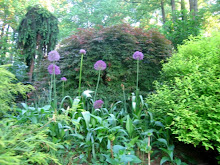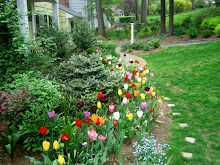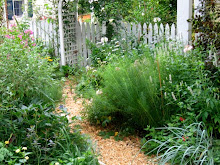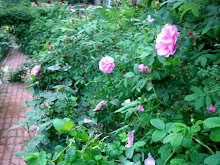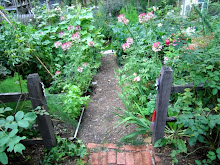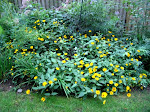As a follow-up to my June 5, 2008 post on Roses Blooming, here is a picture of the perennial sweet pea that I noted. It has pretty little flowers that bloom for me from late July to late August, but no fragrance. I purchased it from Perennial Pleasures Nursery which specializes in heirloom plants. In my Cutting Garden, it grows in full sun, but can also grow in part shade. It is a natural pairing for roses given that--as part of the legume family--it fixes nitrogen in the soil. It requires no maintenance. After the frost, simply cut it to the ground. You can compost the cuttings or simply bury them in your beds.
Welcome to Heirloom Gardener
Wednesday, August 20, 2008
Heirloom Pairing for Heirloom Roses: Picture of a Pretty Pink Perennial Sweet Pea in the Cutting Garden
Posted by
Julia Erickson
at
9:12 PM
3
comments
![]()
![]()
Labels: Annuals/Biennials and Perennials, Roses, Summer Garden
Thursday, August 14, 2008
Garden Bloggers' Bloom Day August 2008 - My Collection of Fragrant Phlox
In anticipation of Garden Bloggers' Bloom Day on May Dreams Gardens tomorrow, here are some of the phlox that have been blooming throughout my garden over the last few weeks. Most are heirloom, some are new, and almost all of them are fragrant.
Posted by
Julia Erickson
at
9:18 PM
10
comments
![]()
![]()
Labels: Annuals/Biennials and Perennials, Garden Bloggers' Bloom Day
Friday, August 08, 2008
Two New Summer Favorites: Double Tiger Lily and Excelsior Lily
My two favorite new lilies this year were the double tiger lily and the Excelsior lily both from Old House Gardens.
Posted by
Julia Erickson
at
9:34 PM
4
comments
![]()
![]()
Labels: Lilies, Summer Garden
Thursday, August 07, 2008
Gardening Blogs are Growing in Chatham, New Jersey
I'm pleased to announce that there are two new gardening blogs from fellow gardeners in Chatham, New Jersey:
Marta McDowell, "a blog about digging in the dirt, growing flowers and vegetables, garden history, horticulture and nature."
Visual Thinking in a Fairmount Garden, "A textile designer among the weeds of her mind."
Posted by
Julia Erickson
at
7:54 AM
4
comments
![]()
![]()
Wednesday, August 06, 2008
Covered Containers for Propagation: GardenTalk.com's Bell Boys
As a follow-up to my post on How to Propagate Hydrangeas, Part I: Taking Cuttings of Sister Theresa, I received several questions about the covered containers that I was using to propagate the cuttings. In response, I am re-posting the pictures of the containers with the information about where I purchased them.
They are from Walt Nicke's GardenTalk: A Catalog of Fine Tools for Gardeners. You can find them under the section Potting and Propagators under the name Bell Boys. They come in two sizes in packages of six.
You can use them to propagate cuttings of other plants too, not just hydrangeas. In fact, I am also propagating the rose Frau Dagmar Harstropp, in another set of these containers just now.
Posted by
Julia Erickson
at
10:58 PM
1 comments
![]()
![]()
Labels: Gardening Tools and Structures, Propagation and Seeds
Nan Ondra, Garden Writer/Blogger, Featured in The New York Times
Nan Ondra, one of my favorite garden bloggers, the genius behind both Gardening Gone Wild (a blogging consortium and host of the Garden Bloggers' Design Workshop) and Hayefield (her personal blog), was featured in last week's New York Times. In the article, "Where Foliage Eclipses Flowers," journalist Anne Raver talks with Nan about her life, her garden, and her books (Nan just published her twelfth).
Posted by
Julia Erickson
at
7:56 AM
0
comments
![]()
![]()
Labels: Gardening Blogs
Tuesday, August 05, 2008
Caterpillars that Sting: Pictures of Saddleback Caterpillars (Acharia stimulea)
I was picking up some rose pruning clippings today when I felt a stinging sensation on my hand. I have never seen this little creature before, but my daughter identified it as the Saddleback Caterpillar, which she had previously seen in one of her science books. Unknown to me, these little creatures can actually sting you from their four distinctive spines. The first picture includes three caterpillars. The second picture includes one of the unhatched eggs. The caterpillar matures into an unremarkable brown moth, that you can see on bugguide.net.
Posted by
Julia Erickson
at
11:19 PM
3
comments
![]()
![]()
Labels: Wildlife in the Garden
"Children have lost touch with the natural world and are unable to identify common animals and plants," according to a UK survey
As a follow-up to my prior post on Richard Louv's book, Last Child in the Woods - Saving Our Children from Nature Deficit Disorder, the UK newspaker, The Independent, ran an article about a UK survey on the subject. Sadly, the journalist Sarah Cassidy reports:
"Half of youngsters aged nine to 11 were unable to identify a daddy-long-legs, oak tree...or bluebell, in the poll by BBC Wildlife Magazine. The study also found that playing in the countryside was children's least popular way of spending their spare time, and that they would rather see friends or play on their computer than go for a walk or play outdoors."
"Experts blamed the widening gulf between children and nature on over-protective parents and the hostility to children among some conservationists, who fear that they will damage the environment. They said that this lack of exposure to outdoor play in natural environments was vital for children's social and emotional development."
"Dr Martin Maudsley, play development officer for Playwork Partnerships, at the University of Gloucestershire, said that adults had become too protective of wild places: 'Environmental sensitivities should not be prioritised over children.'"
"He said: 'Play is the primary mechanism through which children engage and connect with the world, and natural environments are particularly attractive, inspiring and satisfying for kids. Something magical occurs when children and wild spaces mix.'"
Posted by
Julia Erickson
at
7:06 AM
6
comments
![]()
![]()
Labels: Deep Thoughts About Gardening, Gardening with Children
Sunday, August 03, 2008
Picture of an Eastern Tiger Swallowtail (Pterourus glaucus) on a Butteryfly Bush (Buddleia)
Posted by
Julia Erickson
at
10:00 PM
0
comments
![]()
![]()
Labels: Wildlife in the Garden
Saturday, August 02, 2008
More Pictures of This Year's Beautiful Hydrangeas
I'm really enjoying the hydrangeas in my garden this year. Hydrangeas are great because they take so little work and get better year after year. The blooms on hydrangeas are fascinating to watch as their colors mature and change as the blooms age. Below are some pictures of some of the hydrangea in my garden that were not in my Garden Bloggers' Bloom Day post for July.The first two pictures are of an unnamed lace cap hydrangea at the top of Goldberry Hill. Two winters ago this hydrangea was completely killed to the ground. Last summer it grew beautifully, but did not bloom. This year, its unbelievable--loaded with blossoms from head to toe. [Related post: the same lace cap hydrangea in the dead of winter.]
This annabelle hydrangea has been in bloom since June. The blossoms started green, turned white, and recently began turning back to green again. [Related posts: in the winter when it was brown and two weeks ago when it was white.]
This beautiful variegated hydrangea was a new addition to my Front Border last summer. I bought it out of flower for the leaves. I wasn't expecting much out of the flowers and actually thought they would take away from the leaves. But, I was wrong. I love the flowers too.
The pee gee hydrangea, which I posted about pruning back in late winter, is now just starting to bloom, though it is still a week or so away from its peak.
Posted by
Julia Erickson
at
11:03 AM
5
comments
![]()
![]()
Labels: Cut and Forced Flowers, Hydrangeas, Summer Garden
Friday, August 01, 2008
How to Propagate Hydrangea, Part II: Layering Marechal Foch
In completing my expanded Front Border, I wanted to repeat some of the plants that existed in some of the neighboring beds. This first picture is a large, mature hydrangea, which I think is Marechal Foch, across the driveway on Goldberry Hill.
Posted by
Julia Erickson
at
11:08 PM
1 comments
![]()
![]()
Labels: Front Border, Hydrangeas, Propagation and Seeds
Search Heirloom Gardener
Labels
- About Blogging
- Annuals/Biennials and Perennials
- Autumn Garden
- Books and Movies
- Botanical Gardens
- Bulbs and Tubers
- Children's Garden
- Chrysanthemum
- Clematis
- Container Gardening
- Crocus tommasiniasus roseus
- Cut and Forced Flowers
- Cutting and Rose Gardens
- Dahlias
- Deep Thoughts About Gardening
- Egg Garden
- Fences Arbors Walls and Paths
- Floral arrangements
- Front Border
- Fun Stories About Gardening
- Garden Bloggers' Bloom Day
- Garden Bloggers' Design Workshop
- Garden Planning
- Gardening Blogs
- Gardening Tools and Structures
- Gardening with Children
- Goldberry Hill
- Heirloom and Organic Food
- Hibiscus
- Holidays
- Hydrangeas
- Japanese Beautyberry
- Lilies
- Mixed Borders
- New Jersey / Local Interest
- Nurseries
- Online Gardening Resources
- Peonies
- Pest Control
- Picture This Photo Contest
- Piet Oudolf
- Poppies
- Propagation and Seeds
- Pruning and Maintenance
- Roses
- Seed Heads
- Self Seeders
- Shrubs
- Spring Garden
- Summer Garden
- Trees
- Wildlife in the Garden
- Winter Garden
- Zinia
Blog Archive
-
▼
2008
(202)
-
▼
August
(11)
- Heirloom Pairing for Heirloom Roses: Picture of a...
- Garden Bloggers' Bloom Day August 2008 - My Collec...
- Two New Summer Favorites: Double Tiger Lily and E...
- Gardening Blogs are Growing in Chatham, New Jersey
- Covered Containers for Propagation: GardenTalk.co...
- Nan Ondra, Garden Writer/Blogger, Featured in The ...
- Caterpillars that Sting: Pictures of Saddleback C...
- "Children have lost touch with the natural world a...
- Picture of an Eastern Tiger Swallowtail (Pterourus...
- More Pictures of This Year's Beautiful Hydrangeas
- How to Propagate Hydrangea, Part II: Layering Mar...
-
▼
August
(11)









